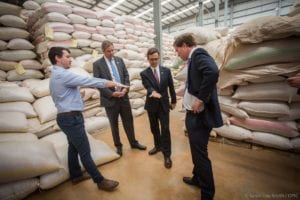 Photo Credit: US Department of the Treasury
Photo Credit: US Department of the Treasury
Chinese Debt Trap Diplomacy and the Economic Cold War in Africa
As the Department of Defense shifts its policies to focus more on great power competition, the US has entered a sort of mini-Cold War with two “revisionist powers” – China and Russia. One arena where this competition plays out is in Africa. Russia has recently sought to regain influence in Africa, and China has been a major player on the continent for some time.
China has become the largest financer of Africa’s infrastructure development. Beijing’s commitment to African development promises completing or building projects that add to or upgrade “30,000km of highways, 2,000km of railways, 85 million tonnes per year of port throughput capacity, more than nine million tonnes per day of clean water treatment capacity, about 20,000MW of power generation capacity, and more than 30,000km of transmission and transformation lines.”
Chinese commitment to Africa has allowed for their influence to grow across the continent – which poses a threat to US national security in the age of great power competition.
The Chinese Investment Model
China has a history of using debt-trap diplomacy to gain influence in smaller states dependent on Chinese investment.
In Sri Lanka, the economy floundered due to huge debts owed to China as part of the Belt and Road Initiative and falling levels of foreign currency reserves. The lack of currency reserves forced Sri Lanka to lease Hambantota port, which was largely funded by the Chinese, back to China for 99 years. Chinese ownership of the port has stoked fears in India – a long time rival of China – that Beijing will use the port to militarize the Indian ocean.
In Africa, China is again using this debt-trap diplomacy model by offering funding for infrastructure projects in states that need them the most, but using their investments to demand greater influence. Thus far, China has used its leverage to secure access to oil reserves in Angola and gain control of strategic ports in Djibouti.
In Angola, the government is using its crude oil reserves, instead of currency, to repay the $25 billion debt owed to Beijing. This approach is troubling because it means Angola’s ability to pay off its debt is dependent on oil prices. Furthermore, it means that the amount of oil Angola can sell to other trading partners is restricted.
Djibouti is home to China’s only overseas military base but could soon give up a key port to Beijing. By the end of 2016, China owned 82% of Djibouti’s foreign debt, and can now use that economic dominance to tap into other East African markets via its foothold in Djibouti.
US Involvement and National Security Implications

US development finance through OPIC helps modernize Rwanda coffee industry.
Photo Credit: OPIC
Development finance is a key part of US foreign policy objectives and ensuring US national security. The 2017 National Security Strategy states, “Trade, export promotion, targeted use of foreign assistance, and modernized development finance tools can promote stability, prosperity, and political reform, and build new partnerships based on the principle of reciprocity.”
Washington has recently made moves to counter Chinese influence in Africa by modernizing the development finance arm of the government for the first time since 1971. In June 2019 the United States International Development Finance Corporation (DFC) was created. The DFC will more than double the available money for investment in low- and middle-income countries with a cap of $60 billion.
The DFC differs from the Chinese investment model in two distinct ways.
First, the DFC will “advance private-sector-led development, resulting in projects that adhere to high standards and are financially viable over the long haul.” This will ensure transparent contracts, sustainable finance, proper assessment of economic and social impacts, and that projects support the local economy’s growth.
Second, the DFC will “help countries sidestep opaque and unsustainable debt traps being laid by Beijing throughout the developing world.” The DFC will also help American businesses invest in new markets, including many that are strategically important to the US.
The creation of the DFC comes at a time when the African economy appears to be ready to take off. Along with potentially positive changes in demographics (an increasing workforce and rising population), intra-continental free trade is now a centerpiece of African economic policy. The African Continental Free Trade Agreement (AfCFTA) has been signed by all but one state (Eritrea), meaning it will encompass 1.3 billion people and $3.4 trillion in GDP.
The creation of the DFC will give African states an alternative to the predatory lending practices of Beijing – at a time when investment is key for the development of African economies. The DFC will also allow the US to effectively compete with China for influence in Africa through the use of development finance.
As the US enters a mini-Cold War with both Russia and China, one of the keys to US success will be their ability to compete for influence with Moscow and Beijing. Increasing the amount of money available for investment in low- and middle-income countries will provide an opportunity for the US to spread their influence in a region that will become increasingly important in the future.






